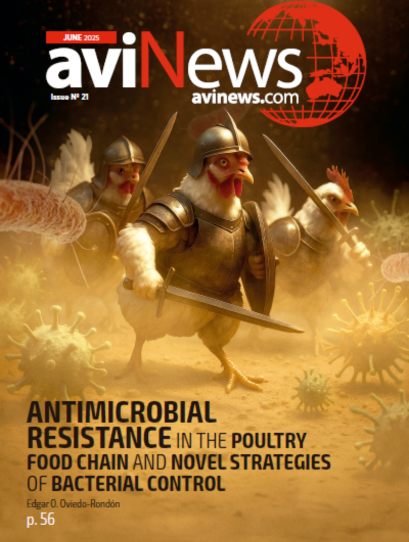Day old chicks are the edge of a short, but intensive growing period. Knowing about their activity cycle, enables a good insight in their behavior during day and night. They need time to eat and rest, individuallly as well as in a flock. This allows providing proper brooding conditions.
By Michael Czarick,
Extension Engineer
Connie Mou,
PhD Graduate Student
and Brian Fairchild
Extension Poultry Scientist
The University of Georgia
Athens, GA USA
A study was conducted on commercial broiler farms examining broiler water usage over the first seven days of a growing period. High-accuracy, ultrasonic water meters were installed in twenty-two broiler houses (eighteen 40′ X 500′ (12 x 150 mtr) houses, four 54′ X 500′ (16 x 150 mtr) houses) on nine farms. The water meters were capable of accurately measuring water flow rates as low as 0.005 gals (0.019 ltr)/min which is 50 times lower than that of the typical poultry house water meter. These meters were accurate and sensitive enough so that chick water usage could be measured on a minute-to-minute basis from the moment the chicks were placed in a house.
Research has shown that water consumption is highly correlated with feed consumption. During the first week, chicks will drink approximately 30 gallons (114 ltr) of water for every 100 pounds (45 kgs) of feed consumed (Alqhtani, 2016). With the high resolution water meters, patterns in chick water consumption and therefore feed consumption were able to be seen that remain hidden with conventional water meters.
Strong circadian rhythm
One of the interesting patterns uncovered is that even when provided continuous light, a flock exhibits a strong circadian (24 hour) rhythm during brooding. The day after chick placement there is roughly twice the amount of drinking/feeding activity during the “day” than there is the following “night” (Figure 1). The pattern becomes less apparent as the week progresses.
By the seventh day there is generally less than a 20% difference between “day” and “night”. It is important to note that only totally-enclosed houses were studied so the amount of outside light the birds were exposed to was minimal if any.
Chicks have an internal clock. This clock plays a role in determining a bird’s level of activity throughout the day by essentially setting a “daytime and a “nighttime”. This clock can be “set” at the hatchery when a chick comes out of the shell or even in the setter when it is still in the egg, depending on the amount of light there is in the setter. Though the primary factor that sets a chicks clock is light, there are other factors than can affect it as well (sound, time of servicing, house temperature, etc). Managers can set a bird’s clock with lighting programs by providing them a prescribed nighttime and daytime. But if a nighttime is not provided, the birds will tend to create one themselves. The fact is with chicks, and older birds as well, though we can provide continuous light in a chicken house there will always tend to be a 24-hour cycle to bird activity (Figure 1).
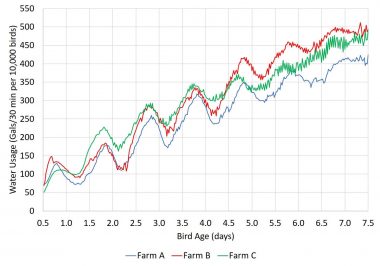
Figure 1. Flock water usage circadian rhythm (Week 1)
On the farms studied the 24-hour activity cycle tended to get weaker over the course of the first week, possibly because there was not a strong “signal” that keeps all the chicks in sync. In nature, the sun rising and falling keeps the birds in a flock set to the same time. The same holds true when there is a prescribed lighting program where the lights turn on and off at the same time each day. But, it appears that providing 24 hours of light may cause the clocks of individual chicks to drift from a
synchronized “flock time”. This is referred to as “free cycling”. The longer the chicks are on continuous light, the weaker the flock activity cycle appears to be. Individual chicks likely remain on a roughly 24-hour diurnal cycle, the issue is that all the chicks might not all be on the same 24-hour diurnal cycle. Since chicks appear to have a 24-hour diurnal cycle a logical question would be is there any harm or possible benefit in providing chicks with a dark period beginning at day of placement? With limited research conducted, there tends to be a fair amount of debate on the subject. Since chicks are growing so quickly during the first week, it wouldn’t be hard to deduce that forcing a 12 hour dark period upon them would adversely affect first week growth rates. Conversely, considering day-old chicks spend a fair amount of time resting, a short dark period of an hour or two would not necessarily adversely affect growth rates. Providing a short dark period could prove beneficial in helping to set the bird’s clocks to prescribed lighting program early on in the growout, instead of abruptly resetting their clocks at seven to ten days of age when lighting programs are typically implemented. Synchronizing their clocks early on my help to eliminate the temporary leveling or reduction in water/feed consumption typically seen after the implementation of a dark period.

Figure 2. First week chick water usage
In addition to the circadian cycle, there was a much shorter “activity cycle” which began between four and eight hours after the chicks had been placed. The activity cycle tended to last between 30 and 60 minutes and is characterized by a large percentage of the chicks eating then resting at the same time. The cycling was relatively weak on the first day on all the farms studied then got stronger as the week progressed (Figure 2).
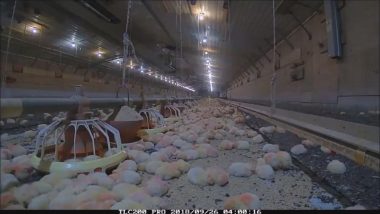
Figure 3. Chick activity cycle (time lapse video)
What does a flock activity cycle look like? At first nearly all the chicks will be resting. Then a few chicks will get up and start moving down the house. Others will join in. It can look like a small wave of chicks moving around the house then stopping to eat and drink which tends to motivate other chicks to eat and drink. The wave progresses down the house to the point were eventually, most of the chicks are eating and drinking. Slowly they stop eating and drinking, then one by one they sit down to rest and sleep and the activity cycle concludes (Figure 3 https://youtu.be/K0LasOTeFC4 ).
It is important to keep in mind that it is part of a flock’s nature to perform activities as a group. When one member of the flock eats, they all tend to eat. When one member of the flock rests, they all tend to rest. After all individuals doing their own thing are more likely to be singled out by predators. Even though the typical broiler house flock is extremely large, this synchronized behavior still tends to be present.

Figure 4. Day one chick water usage
On the first full day following placement (Day 1) the total length of the activity cycle was typically 30 minutes in length (Figure 4). Chick water consumption increased three or four fold over a roughly 15 minute period and then decrease the same amount over the next 15 minutes. The variation in water consumption over the course of the activity cycle, as well as the length of the cycle tended to increase over the course of the first week (Figures 4, 5 and 6). By the seventh day of the flock, there was typically a seven fold variation in water usage from the valley to the peak of the cycle and the cycle length increased to approximately 45 minutes (Figure 6). Previous research has found that the flock cyclic pattern tends to decrease over the course of the flock. This is probably due to the fact that as birds get larger it becomes more and more difficult for all the birds in house to drink and eat precisely at the same time.
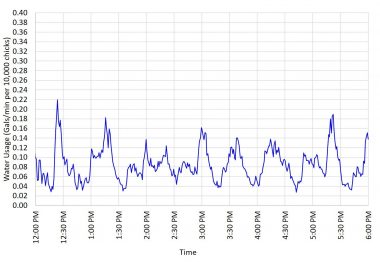
Figure 5. Day 3 chick water usage
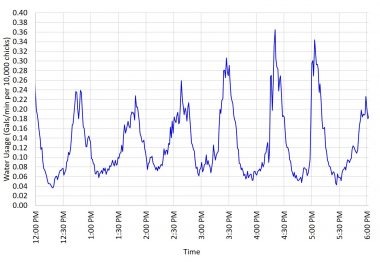
Figure 6. Day 6 chick water usage
It is may be of interest to note that when solid partitions are installed in the brooding area, such as black migration pipes, that the flock activity cycle in the sections will often to be out of sync with one another (Figure 7). This is because the chicks in one section can’t see or interact with the chicks in an adjacent section. That being said when one section becomes very active and noisy it can trigger a flock activity cycle in the adjacent section (Figure 8).
Though more research needs to be conducted, it has been observed that a strong flock activity cycle tends to be associated with better brooding conditions. In houses where the house temperature was lower than optimal, or the drinkers were not set to the right height or pressure, the activity cycle took longer to appear, and when it did, the magnitude of the cycle was much lower. It is not difficult to understand that if the chicks are comfortable and there is plenty of available feed and water they will tend to do things as a group and as a result the feeding/resting cycle will tend to be more pronounced.

Figure 7. Water usage in adjacent brooding sections (Day 6 – 24 hrs.)
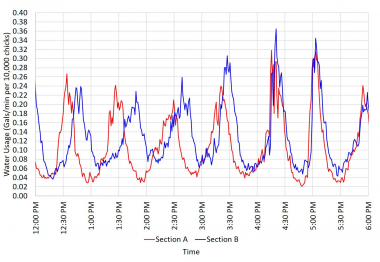
Figure 8. Water usage in adjacent brooding sections (Day 6 – 6 hrs.)
Knowing about the existence of flock activity cycle is important when it comes to chick management.
First, from studying the activity cycle it appears that chicks spend roughly over half of their time resting/sleeping. Since they apparently want to do so as a flock it is perfectly normal to walk into a house and see essentially none of the chicks eating. The lack of feeding activity could go on for 10 minutes or more.
There is nothing wrong. Turning on fans or walking about the house to get them up to eat is simply not necessary. They are young and growing fast, they need time to rest. Secondly, chicks tend to act as a group eating, drinking, and sleeping at the same time. We need to make sure our feeders and drinkers are managed to facilitate all the birds eating and drinking at the same time. Last but not least, it is a reminder that birds have an internal clock and as a result there tends to be a predictability to their actions over the course of a day.
+ Alqhtani, Abdulmohsen Hussen, 2016. The effect of pen size on water to feed ratio of broiler chickens. MS Thesis, University of Georgia.

